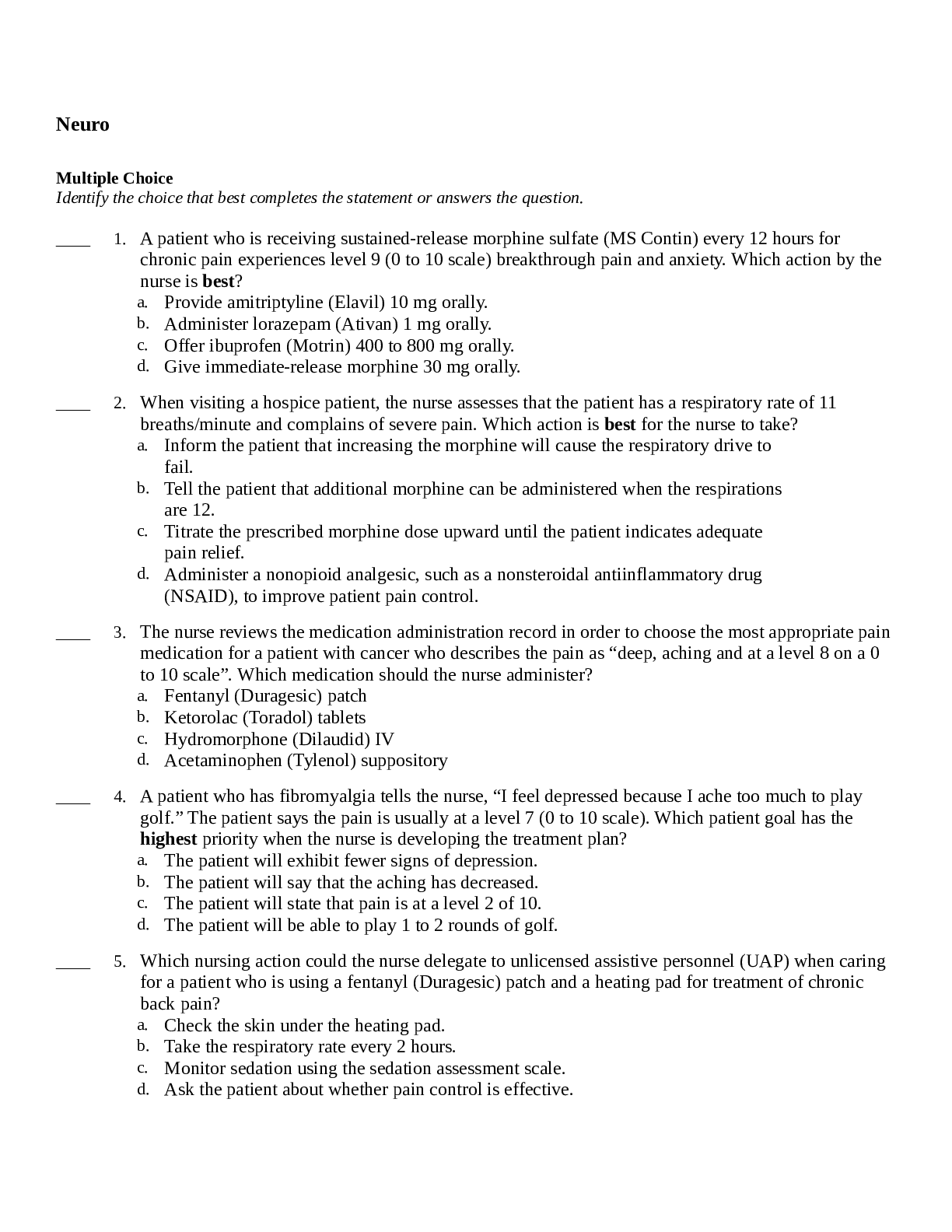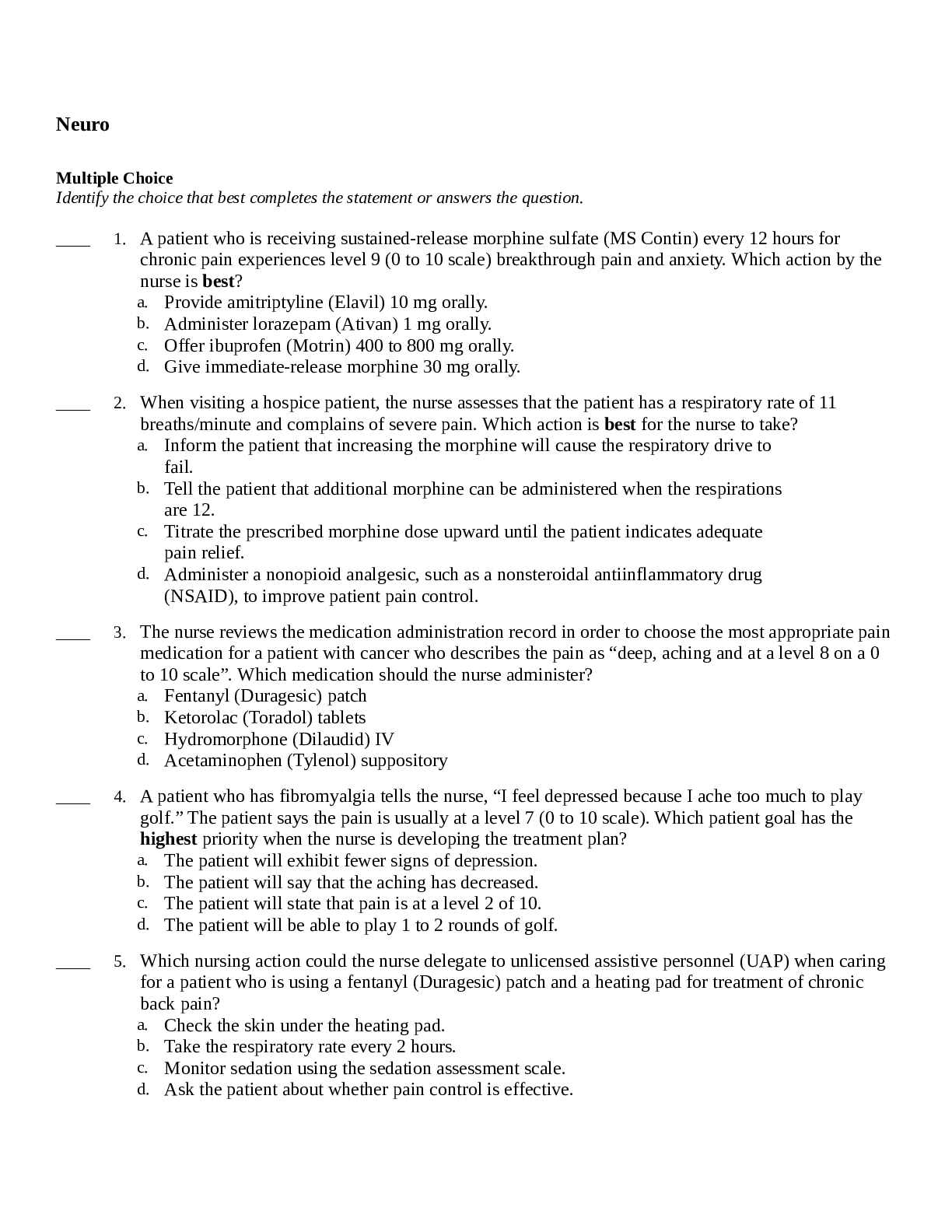1. A patient who is receiving sustained-release morphine sulfate (MS Contin) every 12 hours for
chronic pain experiences level 9 (0 to 10 scale) breakthrough pain and anxiety. Which action by the
nurse is best?
a. Provide amitriptyline (Elavil) 10 mg orally.
b. Administer lorazepam (Ativan) 1 mg orally.
c. Offer ibuprofen (Motrin) 400 to 800 mg orally.
d. Give immediate-release morphine 30 mg orally.
____ 2. When visiting a hospice patient, the nurse assesses that the patient has a respiratory rate of 11
breaths/minute and complains of severe pain. Which action is best for the nurse to take?
a. Inform the patient that increasing the morphine will cause the respiratory drive to
fail.
b. Tell the patient that additional morphine can be administered when the respirations
are 12.
c. Titrate the prescribed morphine dose upward until the patient indicates adequate
pain relief.
d. Administer a nonopioid analgesic, such as a nonsteroidal antiinflammatory drug
(NSAID), to improve patient pain control.
____ 3. The nurse reviews the medication administration record in order to choose the most appropriate pain
medication for a patient with cancer who describes the pain as “deep, aching and at a level 8 on a 0
to 10 scale”. Which medication should the nurse administer?
a. Fentanyl (Duragesic) patch
b. Ketorolac (Toradol) tablets
c. Hydromorphone (Dilaudid) IV
d. Acetaminophen (Tylenol) suppository
____ 4. A patient who has fibromyalgia tells the nurse, “I feel depressed because I ache too much to play
golf.” The patient says the pain is usually at a level 7 (0 to 10 scale). Which patient goal has the
highest priority when the nurse is developing the treatment plan?
a. The patient will exhibit fewer signs of depression.
b. The patient will say that the aching has decreased.
c. The patient will state that pain is at a level 2 of 10.
d. The patient will be able to play 1 to 2 rounds of golf.
____ 5. Which nursing action could the nurse delegate to unlicensed assistive personnel (UAP) when caring
for a patient who is using a fentanyl (Duragesic) patch and a heating pad for treatment of chronic
back pain?
a. Check the skin under the heating pad.
b. Take the respiratory rate every 2 hours.
c. Monitor sedation using the sedation assessment scale.
d. Ask the patient about whether pain control is effective.
____ 6. Which patient with pain should the nurse assess first?
a. Patient with postoperative pain who received morphine sulfate IV 15 minutes ago
b. Patient with neuropathic pain who has a dose of hydrocodone (Lortab) scheduled
now
c. Patient who received hydromorphone (Dilaudid) 1 hour ago and currently has a
sedation scale of 2
d. Patient who returned from the postanesthesia care unit 2 hours ago and has a
respiratory rate of 10
____ 7. To assess the functioning of the trigeminal and facial nerves (CNs V and VII), the nurse should
a. shine a light into the patient’s pupil.
b. check for unilateral eyelid drooping.
c. touch a cotton wisp strand to the cornea.
d. have the patient read a magazine or book.
____ 8. An unconscious male patient has just arrived in the emergency department after a head injury caused
by a motorcycle crash. Which order should the nurse question?
a. Obtain x-rays of the skull and spine.
b. Prepare the patient for lumbar puncture.
c. Send for computed tomography (CT) scan.
d. Perform neurologic checks every 15 minutes.
____ 9. Which nursing diagnosis is expected to be appropriate for a patient who has a positive Romberg test?
a. Acute pain
b. Risk for falls
c. Acute confusion
d. Ineffective thermoregulation
____ 10. The nurse will anticipate teaching a patient with a possible seizure disorder about which test?
a. Cerebral angiography
b. Evoked potential studies
c. Electromyography (EMG)
d. Electroencephalography (EEG)
____ 11. Which nursing action will be included in the care for a patient who has had cerebral angiography?
a. Monitor for headache and photophobia.
b. Keep patient NPO until gag reflex returns.
c. Check pulse and blood pressure frequently.
d. Assess orientation to person, place, and time.
____ 12. Admission vital signs for a brain-injured patient are blood pressure 128/68, pulse 110, and
respirations 26. Which set of vital signs, if taken 1 hour after admission, will be of most concern to
the nurse?
a. Blood pressure 154/68, pulse 56, respirations 12
b. Blood pressure 134/72, pulse 90, respirations 32
c. Blood pressure 148/78, pulse 112, respirations 28
d. Blood pressure 110/70, pulse 120, respirations 30
____ 13. Which action will the emergency department nurse anticipate for a patient diagnosed with a
concussion who did not lose consciousness?
a. Coordinate the transfer of the patient to the operating room.
b. Provide discharge instructions about monitoring neurologic status.
c. Transport the patient to radiology for magnetic resonance imaging (MRI).
d. Arrange to admit the patient to the neurologic unit for 24 hours of observation.
____ 14. Which statement by a 40-year-old patient who is being discharged from the emergency department
(ED) after a concussion indicates a need for intervention by the nurse?
a. “I will return if I feel dizzy or nauseated.”
b. “I am going to drive home and go to bed.”
c. “I do not even remember being in an accident.”
d. “I can take acetaminophen (Tylenol) for my headache.”
____ 15. When assessing a 53-year-old patient with bacterial meningitis, the nurse obtains the following data.
Which finding should be reported immediately to the health care provider?
a. The patient exhibits nuchal rigidity.
b. The patient has a positive Kernig’s sign.
c. The patient’s temperature is 101° F (38.3° C).
d. The patient’s blood pressure is 88/42 mm Hg.
Read More


